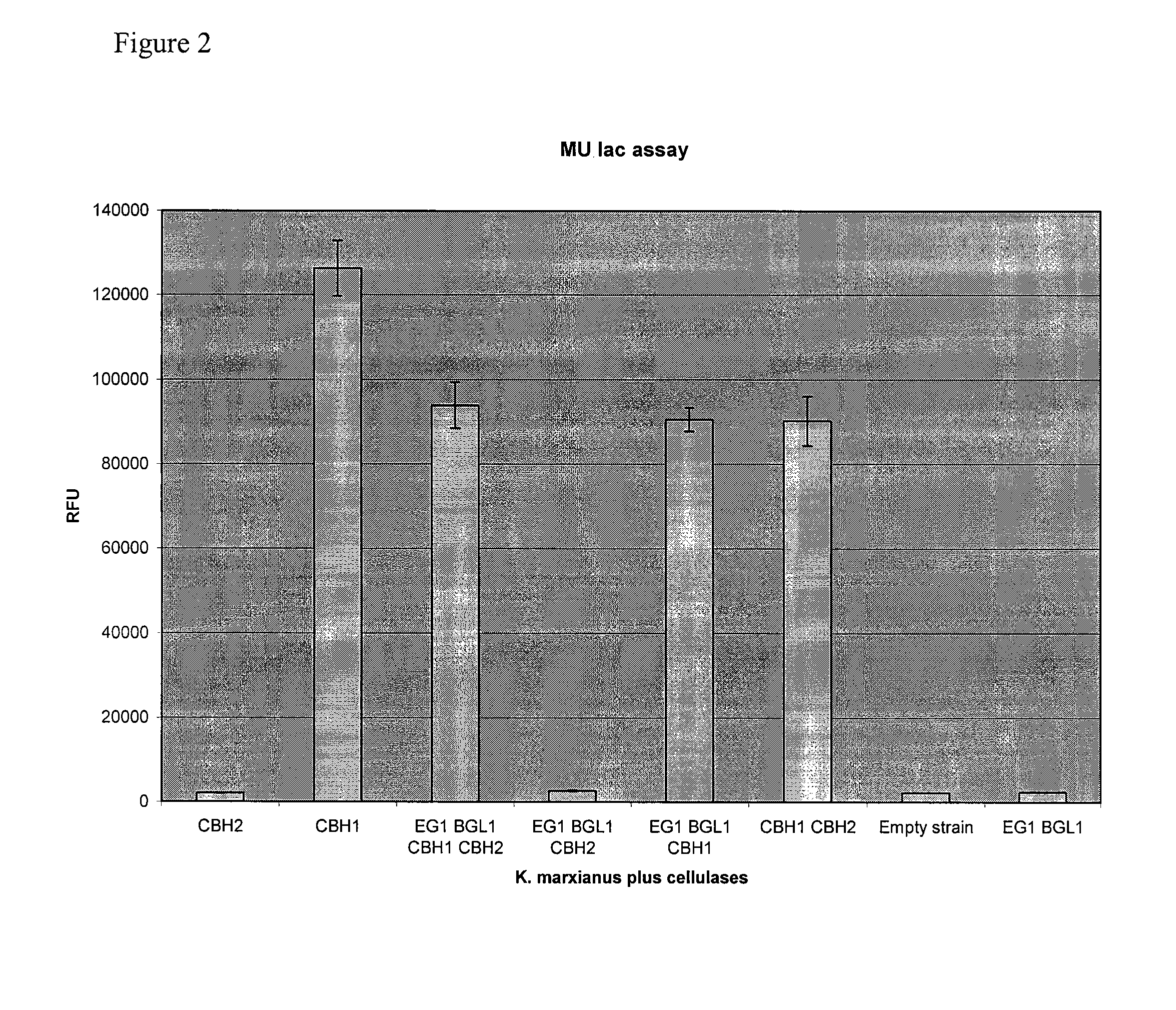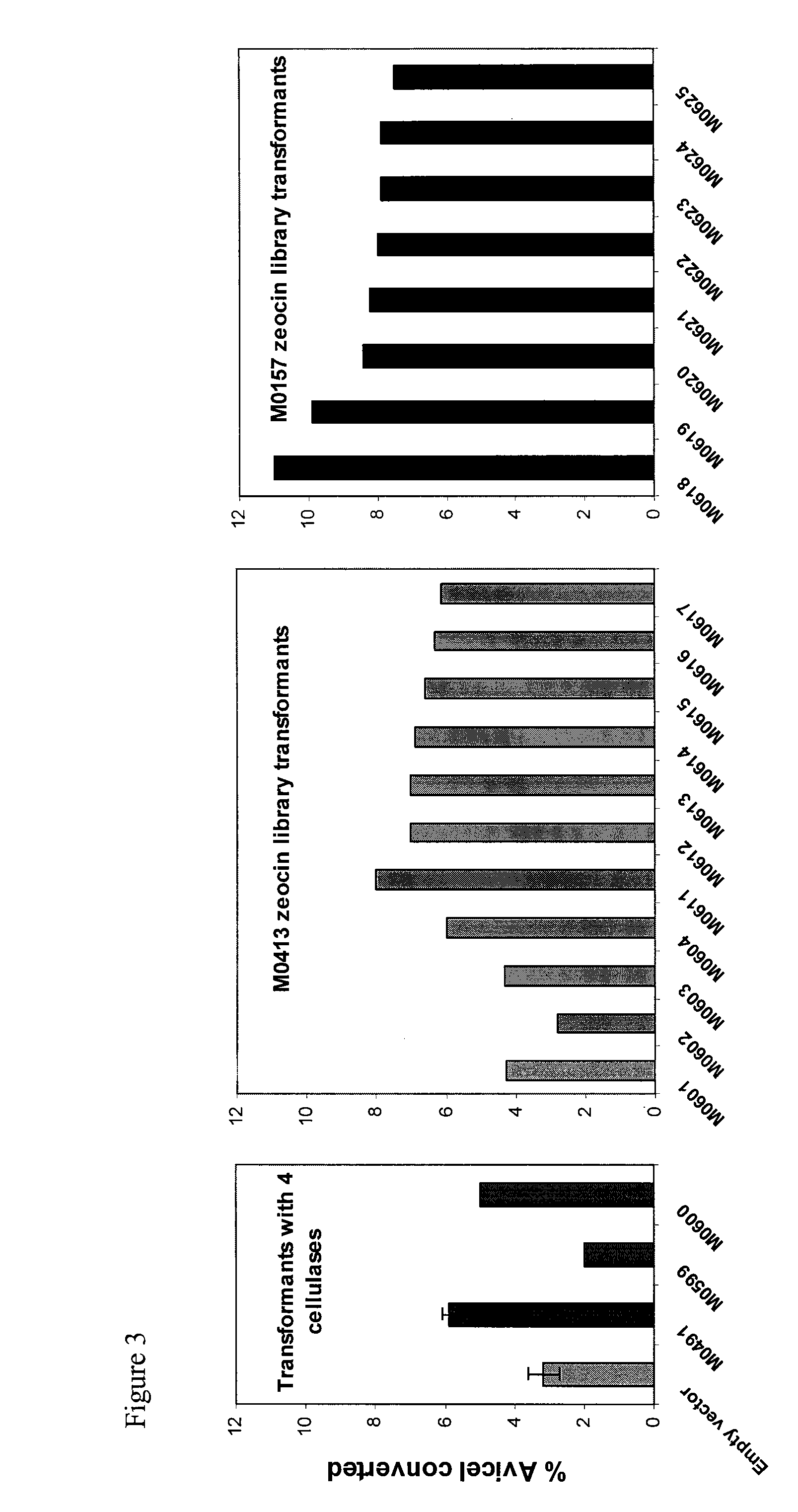Yeast Expressing Cellulases for Simultaneous Saccharification and Fermentation Using Cellulose
a cellulase and yeast technology, applied in the field of yeast expressing cellulases for simultaneous saccharification and fermentation using cellulose, can solve the problems of low-cost technology for overcoming the recalcitrance of these materials, the current expression and specific activity of cellulases heterologously expressed in yeast are still not sufficient to enable efficient growth and ethanol production of yeast on cellulosic substrates without externally added enzymes
- Summary
- Abstract
- Description
- Claims
- Application Information
AI Technical Summary
Problems solved by technology
Method used
Image
Examples
example 1
Production of Kluyveromyces Expressing Heterologous β-Glucosidase and Endoglucanase
[0287]In order to test the ability of Kluyveromyces to express functional heterologous cellulases, two Kluyveromyces strains, Kluyveromyces marxianus (ATCC strain #10606; MO157) and Kluyveromyces lactis (ATCC strain #34440), were transformed with vectors encoding heterolgous cellulases.
[0288]Vectors containing yeast delta integration sequences, the KanMX marker and sequences encoding S.f. BGLI and T.r. EGI (pBKD-BFLI-sEG1) were transformed into Kluyveromyces according to the yeast transformation protocol as described above, and selected on G418. Transformants were verified by PCR and then tested by CMC assay. The results are shown in FIG. 1. The presence of the heterologous cellulase activity is indicated by a clearing zone on the CMC plate. As shown in FIG. 1, neither an untransformed K. lactis strain (colony 8) or an untransformed K. marxianus strain (colony 16) showed endoglucanase activity. Howeve...
example 2
Production of Kluyveromyces Expressing CBH1 and CBH2
[0289]The ability of Kluyveromyces to express functional heterologous cellobiohydrolases was also examined. In these experiments, K marxianus (MO157) was transformed with constructs containing T reesei CBH2, T emersonii CBH1 or both. Similarly, MO414 (K marxianus transformed with Sf. BGLI and T.r. EGI) was transformed with constructs containing T. reesei CBH2, T emersonii CBH1 or both.
[0290]Transformations were performed as described in above. CBH1 activity was then detected using the substrate 4-Methylumbelliferyl-β-D-lactoside (MU-Lac) as described above. The assay was performed on eight colonies of each transformant and the three colonies showing the highest activity were averaged. The results are shown in FIG. 2 and demonstrate that strains transformed with T emersonii CBH1 had high MU-lac activity.
[0291]The activity of Kluveromyces strains expressing heterologous cellobiohydrolases on Avicel was also assessed. In one experimen...
example 3
Production of Kluyveromyces Expressing a Library of Cellulases
[0292]Kluveromyces strains were also created by transforming yeast with a library of cellulases (creation of library was described above). For example, MO413 was transformed with a library of cellulases containing a zeocin marker to produce novel strains MO601-MO604 and MO611-MO617. In addition, MO157 (K marxianus) was transformed with the same library and novel strains MO618-MO625 were identified. Activity on Avicel was assessed at 48 hours as described above, and the results, shown in FIG. 3, demonstrate that Kluveryomces transformed with a library of heterologous cellulases also have Avicelase activity at 35° C. Tranformants of MO157 with the library showed the highest activity. Avicelase activity at 45° C. was also demonstrated (data not shown).
PUM
| Property | Measurement | Unit |
|---|---|---|
| Temperature | aaaaa | aaaaa |
| Temperature | aaaaa | aaaaa |
| Temperature | aaaaa | aaaaa |
Abstract
Description
Claims
Application Information
 Login to View More
Login to View More - R&D
- Intellectual Property
- Life Sciences
- Materials
- Tech Scout
- Unparalleled Data Quality
- Higher Quality Content
- 60% Fewer Hallucinations
Browse by: Latest US Patents, China's latest patents, Technical Efficacy Thesaurus, Application Domain, Technology Topic, Popular Technical Reports.
© 2025 PatSnap. All rights reserved.Legal|Privacy policy|Modern Slavery Act Transparency Statement|Sitemap|About US| Contact US: help@patsnap.com



